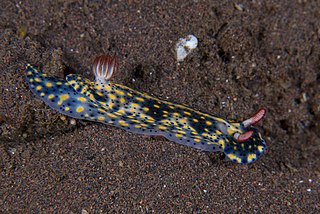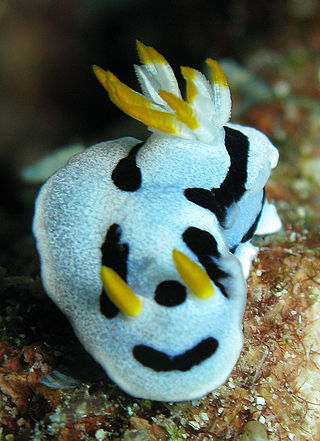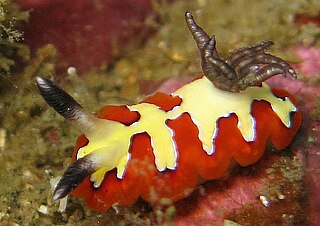
Doriopsilla albopunctata, the white-spotted sea goddess, is a species of dorid nudibranch, a colorful sea slug, in the family Dendrodorididae. It is native to the Pacific Coast of North America, from Mendocino County, California south, possibly to Baja California Peninsula, Mexico.

Ardeadoris cruenta is a species of very colourful sea slug, a dorid nudibranch, a marine gastropod mollusc in the family Chromodorididae. Its name is derived from the feminine form of the Latin word cruentus, which means "stained with blood" and is a reference to the red spots on its upper dorsum. It was transferred to the genus Ardeadoris on the basis of DNA evidence.

Hypselodoris infucata is a species of colourful sea slug or dorid nudibranch, a marine gastropod mollusk in the family Chromodorididae.

The three-spot nudibranch, scientific name Aldisa trimaculata, is a species of sea slug, a dorid nudibranch, a marine gastropod mollusc in the family Cadlinidae.

Chromodoris dianae is a species of sea slug, a dorid nudibranch, a shell-less marine gastropod mollusc in the family Chromodorididae.

Goniobranchus fidelis, also commonly known as the faithful sea slug, is a species of colourful sea slug, a dorid nudibranch, a marine gastropod mollusc in the family Chromodorididae.

Goniobranchus tumuliferus is a species of colourful sea slug, a dorid nudibranch, a marine gastropod mollusc in the family Chromodorididae.

Goniobranchus tritos is a species of colourful sea slug, a dorid nudibranch, a marine gastropod mollusk in the family Chromodorididae.

Goniobranchus rubrocornutus is a species of colourful sea slug, a dorid nudibranch, a marine gastropod mollusc in the family Chromodorididae.

Goniobranchus sinensis is a species of colourful sea slug, a dorid nudibranch, a marine gastropod mollusc in the family Chromodorididae.

Hypselodoris maridadilus is a species of colourful sea slug or dorid nudibranch, a marine gastropod mollusk in the family Chromodorididae. It feeds on sponges.

Hypselodoris nigrostriata is a species of sea slug or dorid nudibranch, a marine gastropod mollusk in the family Chromodorididae.
Hypselodoris babai is a species of colourful sea slug or dorid nudibranch, a marine gastropod mollusc in the family Chromodorididae.
Hypselodoris flavomarginata is a species of sea slug or dorid nudibranch, a marine gastropod mollusk in the family Chromodorididae.

Hypselodoris maritima is a species of colourful sea slug or dorid nudibranch, a marine gastropod mollusk in the family Chromodorididae.

Hypselodoris nigrolineata is a species of colourful sea slug or dorid nudibranch, a marine gastropod mollusk in the family Chromodorididae.

Hypselodoris regina is a conspicuous species of sea slug or dorid nudibranch, a marine gastropod mollusk in the family Chromodorididae.
Mexichromis similaris is a species of sea slug or dorid nudibranch, a marine gastropod mollusk in the family Chromodorididae.
Mexichromis lemniscata is a species of colourful sea slug or dorid nudibranch, a marine gastropod mollusk in the family Chromodorididae.

Diversidoris crocea is a species of colourful sea slug, a dorid nudibranch, a shell-less marine gastropod mollusk in the family Chromodorididae.
















